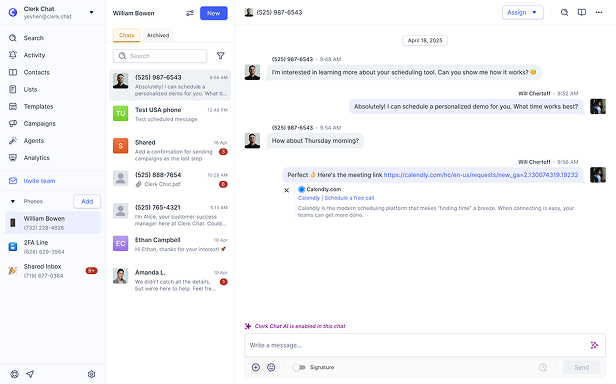How to Use Conversational Customer Engagement to Build Relationships
By Alexander Haque
- Published: May 23, 2025
Customer preferences are changing. Today’s consumers want transparent, authentic, and human interactions with companies. They want to build personal relationships with the brands they love, which is why conversational customer engagement strategies are becoming increasingly valuable.
According to a report from IDC, around 80% of companies today use or plan to implement conversational engagement efforts into their processes.
A conversational approach to engaging customers (and keeping them engaged) can significantly improve customer experiences, boost retention rates, and even turbocharge your profits. But what exactly is conversational customer engagement – how does it work, and how can you start unlocking the benefits for your business? Read on to find out.
In this article:
Defining Conversational Customer Engagement
So, what is conversational customer engagement? In simple terms, it’s a strategy that uses AI-powered chatbots, automation, and other technologies (like a two-way messaging service) to help companies build deeper connections with customers.
On a broad scale, it’s all about encouraging your customers to have genuine conversations with your customer service agents, sales specialists, subject matter experts, and AI-powered SMS bots.
Through these one-on-one chats, across multiple channels, team members and carefully trained AI bots can answer customer queries, provide expert opinions, and even recommend specific products or services to customers and leads. The result isn’t just higher conversion rates – it’s improved trust and stronger relationships with your target audience.
Turn conversations into conversions. Build relationships with Clerk Chat.
Conversational Engagement vs Conversational Marketing
If the concept of conversational engagement sounds familiar, you may already be familiar with conversational marketing. Conversational marketing is similar to conversational engagement because both strategies focus on building customer relationships through two-way discussions.
With conversational marketing, companies leverage conversational messaging bots, two-way chat tools, SMS, social media, and other channels to interact with leads and guide them through the sales funnel. The main difference is that conversational marketing targets customers at the top of the funnel, sending leads and customers content that drives conversations.
For instance, you might send personalized text messages to your customers that highlight specific product features and benefits, allowing them to talk to a specialist or bot if they have any additional questions. From that point, conversational customer engagement takes over.
With the engagement part of the strategy, you focus more on customers who have already shown interest in your products or services or purchased items. Agents and bots answer incoming questions about products and services and send follow-up messages to ultimately push them towards a purchase.
The Role of Technology in Conversational Engagement
Ultimately, the success of your conversational customer engagement strategy hinges on your ability to use the right technology to manage discussions with customers at scale. You’ll need tools that facilitate genuine two-way conversations with buyers across various channels, such as:
Conversational Platforms
Conversational platforms are essentially hubs for engaging and communicating with customers. They might include a combination of different tools, such as business texting solutions (for two-way conversations), social media messaging apps, and more. They also typically feature:
- Chatbots or assistants powered by conversational artificial intelligence
- Conversational user interfaces (messaging apps)
- NLP engines to support voice and text input
- Chatbot orchestration and fine-tuning tools
- Dialogue management features
- Training data for bots and assistants
- Third-party integrations with other tools (like a CRM integration)
Integrations and APIs
We mentioned integrations above, but APIs and integrations are worth mentioning in their own section, because they form a crucial part of a strong conversational customer engagement strategy. These tools ensure you can bridge the gaps between the various tools you use to communicate with customers, from your group texting service to messaging apps like WhatsApp.
This ensures you can deliver a consistent customer experience, maintaining the context of conversations as they move from one channel to the next. APIs and integrations also allow you to connect your messaging tools with your CRM platforms, making it easier to personalize discussions and build more comprehensive customer profiles.
Plus, they can enable collaboration between various team members. For instance, a Microsoft Teams SMS integration can ensure that all your sales, marketing, product, and customer service teams can work together to build impressive customer experiences.
AI and Automation
When you’re engaging with customers “conversationally”, automation and AI are valuable tools. Although today’s customers want personalized experiences, they also want answers to their questions quickly. Using AI in customer service, marketing, and sales strategies helps teams respond to large volumes of customers quickly and effectively.
Aside from improving response times, AI and automation can simplify scaling your conversational engagement strategy. For instance, you can use advanced tools to schedule SMS messages to reach customers at a specific time when you need to “follow up” on a conversation.
You can also use AI and automated messages to keep the conversation going over time, such as sending messages that update customers about new products, or using SMS appointment reminders to keep customers informed of upcoming meetings or consultations.


The Benefits of Conversational Customer Engagement
So, why is it so important to consider investing in conversational customer engagement? These days, customers expect businesses to invest in building genuine relationships with them. If you’re not taking the time to communicate consistently with your audience, you’ll miss out on opportunities to grow.
You could even end up losing your most valuable, loyal customers. With a conversational approach to engagement, businesses can:
Enhance Customer Communications
The way we communicate has changed. Most people (particularly younger generations) don’t dedicate a lot of time to phone calls and face-to-face discussions anymore. They’re used to using customer service messaging tools and social media for convenient conversations.
With messaging solutions, from SMS to WhatsApp and Facebook Messenger, customers can quickly ask questions, access crucial information, and even send images, GIFs, documents, and more to people anywhere in the world at any time. Conversational engagement strategies ensure you can have valuable conversations with customers without the need for phone calls.
Turn conversations into conversions. Build relationships with Clerk Chat.
Improved Customer Experiences
Investing in conversational strategies for customer engagement isn’t just about meeting your audience on their terms. It’s about giving them the experience they crave. Countless reports highlight the growing value of this approach to connecting with customers.
For instance, Salesforce found that 71% of customers want companies to communicate with them in real time. Twilio found that 90% of customers want the option to use messaging apps when contacting a business. Using conversational methods to reach your customers shows them that you care about their preferences and want to give them a streamlined, convenient experience.
Better Operational Performance
Conversational customer engagement efforts don’t just benefit customers – they can turbocharge team performance too. For instance, with automation tools and conversational AI for customer service, you can empower bots to handle various tasks, from proactively sending messages to customers about recommended products to answering common questions.
This means your human employees have more time to focus on more strategic, creative processes that require human skills like empathy and problem-solving. Your human employees can focus on the more complicated marketing, sales, and customer service challenges, while bots handle the rest, allowing your team to accomplish more with less.
Use Cases and Strategies for Success
So, what does conversational customer engagement look like in action? We’re still in the early stages of discovering what a conversational approach can do for businesses. But here are some ideas and use cases for companies in different industries to consider:
Healthcare: Transforming Patient Experiences
Modern consumers are understandably cautious about who they trust with their health and well-being. Healthcare organizations need to earn the trust of their audience by regularly communicating with them, checking in on their progress, and providing them with useful insights.
Conversational engagement strategies are extremely useful here. For instance, healthcare providers can use a conversational SMS solution to send customers information about upcoming appointments and answer questions they might have about how to prepare. They can also request patient feedback or distribute useful health tips (generalized for HIPAA compliance).
With a conversational AI tool, healthcare organizations can ensure they always have an option to answer urgent customer queries, book new appointments, and manage patient needs.
Retail and Ecommerce: Increasing Sales and Loyalty
Many companies already use messaging to engage and support customers in the retail landscape. For instance, they might use transactional SMS messages to confirm orders or help buyers keep track of products in transit.
With conversational customer engagement tactics, retailers can take customer interactions to the next level. For instance, they can create bots that immediately respond to customer questions about products, guide them to the right item for their needs, and help them complete orders.
Retail teams can also share content with customers, ask for feedback, introduce them to new products, and find out if they want to pre-order. This can help accelerate sales and increase average order values. The key to success here is making sure you have the right combination of team members and AI customer service tools throughout the funnel.
Subscription Services: Boosting Lifetime Value
Subscription businesses among the companies most likely to benefit from conversational commerce and engagement strategies. They need to keep customers engaged constantly, so they continue to renew their subscriptions, month after month.
Subscription companies can use a bulk SMS solution to immediately send useful messages to customers about upcoming renewal terms, changing product options, or even tips on how to make the most of the product they’re purchasing.
They can also request regular feedback and assist customers with determining when they might want to upgrade to a more expensive package or even temporarily put their subscription on hold. This can help increase customer loyalty and lifetime value.
Service Providers: Building Deeper Relationships
Service providers depend on strong customer relationships to ensure repeat sales and transform buyers into advocates for their brand. A conversational customer engagement strategy can help service providers strengthen customer connections.
For instance, a home service provider could send text messages or notifications to customers, reminding them about maintenance services, introducing them to referral programs, or asking them to leave business reviews. A professional service firm, on the other hand, could use B2B SMS marketing strategies to share guidance and tips with buyers or invite them to explore more expensive plans.
Service providers can use conversational tactics to encourage buyers to take advantage of service subscription packages, increasing their chances of repeat business from loyal customers.
Conversational Engagement Implementation: Top Tips
Implementing conversational customer engagement strategies into your business processes doesn’t have to be complicated. All you really need is the right messaging and communication tools and a plan for guiding customers through the sales funnel.
Here are our top tips for a successful implementation:
Embed Conversational Engagement into Messaging Strategies
First, start with your existing messaging strategy. Are you already using platforms to send texts to multiple contacts without group messaging, or send mass marketing notifications to customers? If so, look for new ways to engage and delight your audience consistently.
For instance, use automation and AI tools to send follow-up messages to customers asking about past queries (such as when they requested information about a product). Invite customers to talk to your team members when they contact your organization asking about a service. Send out regular surveys and feedback requests, and thank your customers for their insights.
Focus on connecting with customers across multiple channels, from SMS to RCS, live chat, social media, and more, so they have options for how to reach you. At the same time, ensure you’re familiar with messaging compliance standards, such as 10DLC SMS compliance, and SMS opt-in and opt-out best practices, so you’re not putting your company at risk.
It’s also worth monitoring the results of your messaging campaigns, so you can gain direct insights into strategies for improving SMS deliverability, customer engagement, and response rates.
Create Engagement-Focused Templates
If your team is new to using messaging solutions for “conversational engagement” or you’re planning on training a chatbot or virtual assistant to handle your strategy for you, templates are extremely useful. They allow you to ensure you can maintain a consistent tone of voice and even comply with specific messaging standards when you contact your customers.
For instance, here are some examples of templates you might use:
- Following Up: “Hi [Name], Scott from [Company] here. I hope I answered your questions last time we spoke about [topic]. However, if you have any more questions, just hit reply and I’d be glad to help. Text STOP to stop getting these texts.”
- Driving sales: “Hey [Name], are you still considering buying [product/service]? We have some great offers available right now. Reply to this text, and I’ll see if I can help you find an amazing deal! Text STOP to stop getting these texts.”
- Requesting feedback: “Hi [Name], looks like your order has been delivered. Are you happy with it? We’d love to get your feedback. Please leave us a quick message here [link to review site], and we’ll enter you into a prize draw! Text STOP to stop getting these texts.”
If you need some more tips on how to master SMS marketing (conversational or otherwise), you can find our SMS marketing guide here.
Invest in Conversational AI
Having in-depth, personal conversations with your customers can be difficult at scale if you have a limited team. That’s why conversational AI tools are emerging as a critical part of any extensive conversational customer engagement strategy.
These powerful tools can handle a range of interactions on your behalf, using A2P messaging to follow up with customers, send valuable content to buyers, and request feedback. That means your human employees can focus on other, more important tasks.
The important thing to remember with conversational AI is that customization is key. Make sure your bots share your brand’s tone of voice and have access to your data from CRMs and knowledge bases, so they can answer questions more effectively. Ensure you’re implementing strategies to keep customer data safe, and always give your buyers an option to escalate their questions to a human.
Keep Customers Engaged with Clerk Chat
The future of customer engagement is conversational. The more you invest in having valuable, personalized, and human discussions with your customers, the more likely you are to earn their trust – and turn them into lifelong buyers (and advocates for your brand).
Fortunately, all you need is the right technology to get started. Clerk Chat makes conversational customer engagement easy, with templates for automation across channels, a customizable conversational AI agent for handling common queries and follow-up messages, and more.
With Clerk Chat, you can reach, nurture, convert, and support customers on every messaging channel, from SMS to WhatsApp to RCS. Plus, our platform integrates with all your existing business tools, from CRM platforms to collaboration apps like Microsoft Teams.
Ready to improve the lifetime value of your customers? Contact Clerk Chat today.
Alex is passionate about building truly groundbreaking technology that serves humanity. He strives to encourage work environments where teams show up authentically and are empowered to contribute their best work. Before Clerk Chat, Alex built, scaled, and sold Retinad VR, followed by working in partnerships and innovation at Samsung and Netflix, helping enable large-scale projects and products. In his free time you can find him gravel biking and reading philosophy.
In this article:
Ready to use your business number for text messaging?
Thousands of businesses are already experiencing the power of conversational messaging through SMS. Join us. Free trial and paid tiers available.
Get Started#Subscribe
Get product updates in your inbox
Tutorials, features, and Clerk Chat news delivered straight to you.




